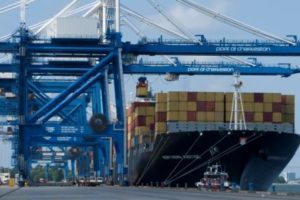It only takes one: How a single shipping container could cripple the world’s economy
The Port of Charleston, South Carolina is the 9th largest container port in the United States, handling close to 160 thousand containers annually. So, what could get authorities to shut down this cog in our nation’s commerce for seven hours? The short answer is, a prank call and a dirty bomb. On the night of June 14, 2017, the Charleston Coast Guard received a warning about a possible dirty bomb on the container ship Maersk Memphis. This resulted in authorities shutting down the port for seven hours in order for four containers to be pulled off the ship and scanned for signs of hazardous radiological material. Normal operations resumed at 3:30 am after the containers had been cleared. It was later discovered that the warning call had in fact been a prank by a conspiracy theorist, who had live streamed the entire event on YouTube.

This event exposed the potentially fatal flaws that exist in the current container security regime. Currently, only three to four percent of shipping containers entering ports are subject to scanning for radiological material. Scanning is done after individual containers have been flagged by the Department of Homeland Security’s Automated Targeting System (ATS), usually after the containers have been stacked in anticipation of being loaded onto a ship. Scanning then involves locating where these containers have been stacked, pulling them from their stacks, scanning them, and then replacing them in their stack. This process is made even more tedious if a container has already been loaded onto a ship, as evidenced by the fact that it took the authorities seven hours to scan four in Charleston. Though the Charleston event turned out to be a hoax, in 2002 ABC news shipped 15 pounds of depleted uranium in a mock dirty bomb from Istanbul to New York in a shipping container, without the container being stopped or inspected once.
Authorities in the United States tried to address these gaps and improve the international container security regime through the passage of the SAFE Ports Act of 2006. One of the provisions of the act mandates the screening of all containers bound for the United States for radiological material prior to their arrival. The deadline for the implementation of this mandate was initially set for 2012, however this deadline has been continuously delayed, and is yet to be implemented. This delay occurred due to the complaints of private port operators about the cost of implementing this mandate and the effect it would have on container velocity. These concerns have to be heeded because, as noted by Global Resilience Institute (GRI) Founding Director Dr. Stephen Flynn in his book “The Edge of Disaster,” “securing critical infrastructure is as much about the public’s well-being as about safeguarding private interests.”

There have been several mechanisms suggested for the implementation of the screening mandate. Among these is a report produced by GRI with funding from the MacArthur Foundation, which suggests an international framework for the scanning of containers. The framework calls for scanning 100 percent of containers as they enter the port accompanied by automated secondary scanning techniques for containers suspected to contain hazardous radiological material. Another recommendation has been the construction of a series of fully automated offshore ports, where containers from foreign ports could be offloaded, scanned, and then routed to ports on the mainland.
Regardless of the mechanism used to achieve the SAFE Ports Act mandate, scanning 100 percent of containers is a key step to building a resilient global supply chain. The consequences of a disruption to the global shipping industry cannot be understated. Approximately 90 percent of global trade by volume travels by sea, with 60 percent of this moving by shipping container. Even more compelling are the estimates that an extended shutdown of the Ports of Los Angeles and Long Beach due to the detonation of a dirty bomb could cost tens of billions of dollars and severely impact the performance of the US economy. While shippers have become adept at handling normal disruptions to the international supply chain, incidents like the prank call at the Port of Charleston highlight the major vulnerability that port security poses to the global economy. With so much of the world’s commerce and movement of vital goods dependent on a security regime that can be gridlocked by a simple phone call, there is a glaring need for the public and private sectors to collaborate and implement new processes that can prevent disruptions in the first place and, just as importantly, quickly resolve alerts and recover when threats do arise.
Sources and Further Reading
Top 30 U.S. Ports: Finding the right balance – Logistics Management
Conspiracy Theorist’s Dirty Bomb Tip Shut Down South Carolina Port Overnight – Time Magazine
June 17th, Did We Find Uranium One Containers in Charleston – George Webb
Debate reignites of container scanning of US imports – Journal of Commerce
DHS/CBP/PIA 006 Automated Targeting System – Department of Homeland Security
Customs Fails to Detect Depleted Uranium – ABC News
Meeting the Requirements of the SAFE Port Act – Homeland Security Today
A risk and economic analysis of dirty bomb attacks on the ports of Los Angeles and Long Beach – Risk Analysis
